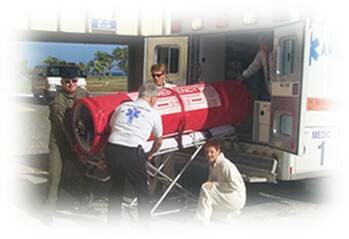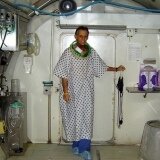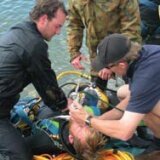Hyperbaric Chamber

Often called an oxygen chambers or decompression chambers - Hyperbaric Chambers are sealable vessels or rooms in which therapeutic gas is supplied by an air compressor.
Internal atmospheric pressure inside the chamber can be gradually raised, lowered and maintained according to special treatment program called treatment protocol.
The chamber is constantly monitored for proper levels of oxygen and carbon dioxide.
Oxygen chambers, decompression chambers, recompression chambers - all these names are pointing to essentially the same type of devices capable to perform identical or similar operations.
Hyperbaric Chamber's Anatomy
Among major elements of a hyperbaric chamber are pressure compartment large enough to accommodate one or more patients and a system for pressurizing the chamber.
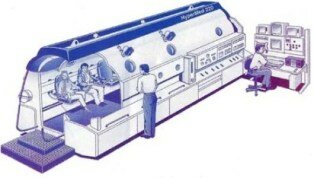
Oxygen is piped into the chamber through one or more tubes penetrating the pressure containing body of the chamber. Exhaled air is exhausted from the pressure compartment. Oxygen is usually provided from high pressure oxygen cylinders bank maintained outside the chamber.
Two patterns for pressurizing the chamber are common:
- The same oxygen used to pressurize the chamber is serving as therapeutic gas for patients to breathe;
- Oxygen is provided to patient via oxygen mask or hood assembly, and air is used to pressurize the chamber.
Both patterns are designed to eliminate breathing resistance and allow considerable degree of movement for the person.
The entire hyperbaric treatment system usually includes several sub-systems and components like environmental air conditioning systems for temperature comfort and humidity control, ancillary support systems, high pressure medical oxygen concentrators, medical oxygen tanks, cryogenic oxygen systems, banks of pressurized bottles and/or other medical oxygen supplies.
In many hospitals or medical centers back-up independent emergency air or oxygen supplies system are installed and maintained. The fire suppression systems are in place providing complete fire protection for chamber elements. All these are controlled from the operating terminals.
The hyperbaric chamber is an integral part of a complex hyperbaric treatment system which includes many components and sub-systems designed to insure effective, safe and even pleasant hyperbaric oxygen treatment.
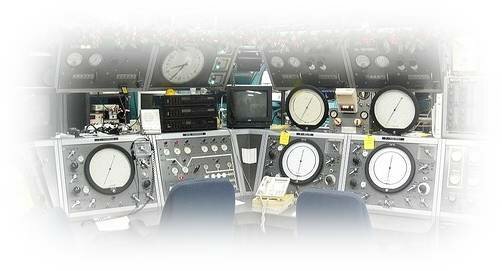
Photo courtesy of "Integrity Of Light"
There are several basic categories of chamberses: Multiplace, Monoplace, Portable and TRCS (Transportable Recompression Chamber System).
Another type of Hyperbaric Chambers, a Mild Portable Hyperbaric Chambers is representing comparatevely new direction in Hyperbaric Treatment called mild portable hyperbaric medicine or HBT. HBT differs from HBOT in two ways:
- pressure less the 1.5 ATA is used
- the regilar air containing 21% of oxygen, rather then pure medical oxygen is used as a therapeutec gas.
Multiplace Hyperbaric Chambers
Multiplace Chambers are designed to treat more than one person at a time facilitating treatments under higher internal pressure - up to 6 ATA, which extends the scope of treated conditions. The design patterns, capacity, size, pressure compartments structure and accessories are varying, often because many big multiplace chambers are built to accommodate the hosting hospitals specific requirements. Read more about Multiplace Hyperbaric Chambers...
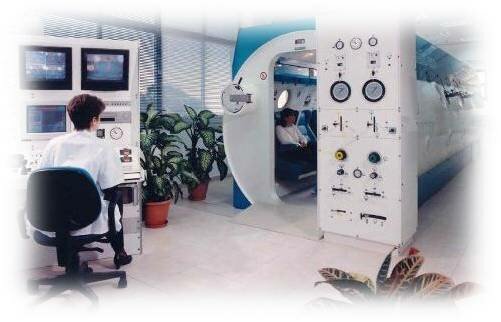
Photo courtesy of Hyperbaric Oxygen Treatment Center At Elisha Hospital
Monoplace Hyperbaric Chambers
Monoplace Chambers are designed to treat one person at a time. Monoplace Chambers pressure compartment is typically a cylindrical metal or acrylic crystal clear tube allowing a person to observe her surroundings and facilitated with increased comfort and mobility features. Read more about Monoplace Chambers...
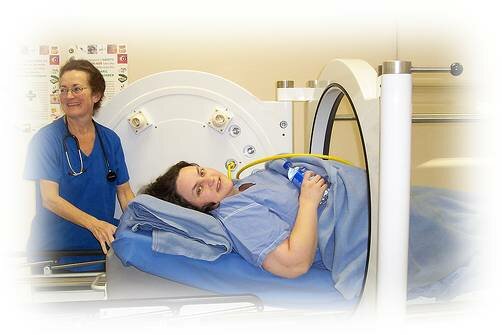
Photo courtesy of "Leitharenea"
Transportable Recompression Chamber System (TRCS)
Conically shaped monoplace hyperbaric chamber below is a Transportable Recompression Chamber System (TRCS) uniquely designed for emergency evacuation and treatment of decompression sickness, air embolisms, blast injuries, smoke inhalation as well as victims of accidents, disasters, terrorist acts and military conflicts. This TRCS can be easily installed on any kind of transport craft - fixed wing, rotary blade, seacraft and road vehicles. Today there is a real need for such mobile rescue capsules in the world. Currently there are significant deficiencies in providing a more efficient life support means while transporting casualties to a medical facilities.
The five-year research and development phase of this unique two-piece monoplace hyperbaric chamber commenced in 1982. Robert Sands, the designer and patent holder of this unique Transportable Recompression Chamber System, worked with many worlds foremost hyperbaric research facilities and also with the U.S. Navy on a collaboration basis. Read more about Robert Sands and TRCS
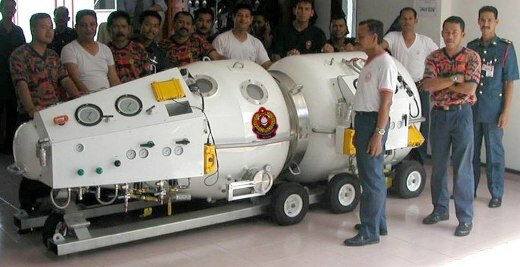
Photo courtesy of Robert L. Sands
Portable Hyperbaric Chambers SOS Hyperlite
Portable hyperbaric chambers SOS Hyperlite is compact and can be easily stored for almost immediate use, when no other hyperbaric facility is available onsite, or the existing equipment is in use treating other patients.
Being so portable, and not requiring installation, portable hyperbaric chambers can be used anywhere in the building away from busy areas, to isolation bays if necessary, simply by pushing it around on a hospital trolley.
Imagine this scenario... In the smoking ruins of a city following an earthquake or volcanic eruption, during a wild fire or following a terrorist attack, theres one factor that is paramount in saving lives: the speed by which first responders can deliver effective medical treatment to casualties. Its the age old story suffer major trauma in a remote mountain region and statistically, your chances of survival are far less than someone who receives similar injuries outside the front door of a citys emergency trauma center.
Mind you, Ive seen response to emergency scenarios more akin to silent movies such as the Keystone Cops where C&C (Command & Control) is soon replaced by Chaos & Confusion. The terrorist bomb detonates in the crowded city center: everyone dials the emergency number at once from a hundred mobile phones. Fifty ambulances rush to the incident causing their own traffic jam and inevitable delays. Soon after their arrival jammed into every tiny side street a second device blows up in another location 2 miles away.
Ambulances cant move: nobody is quite sure which ambulance should go where (even if they could move) or they all end up returning to the nearest hospital while three or four other major trauma centers remain empty. Such a scenario easily happens. The idea that the ambulance can arrive with a portable hyperbaric chamber on board must be a clear step in the right direction.
The patient suffering from blast injuries, blood loss, Carbon Monoxide Poisoning or smoke inhalation can be immediately treated and whats more if the ambulances departure to or arrival at the citys trauma center is delayed for any reason the casualty can continue to receive effective treatment that might be the difference between life & death. Read more about Portable Hyperbaric Chambers...
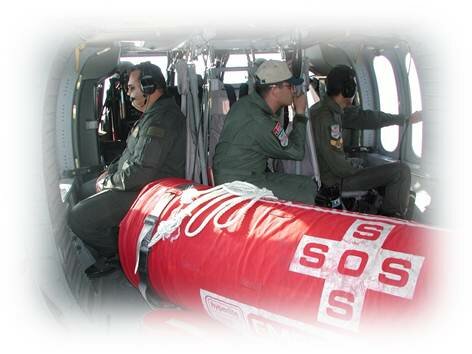
Photo courtesy of SOS Hyperlite Ltd.
The Initial Users Of Decompression Chambers
During the last century treatment in decompression chambers proved to be a single effective method to heal Arterial Gas Embolism (AGE) and Decompression Sickness - both conditions are very common in Scuba Diving and Navies.

Photo courtesy of RobW
Decompression Sickness (DCS) usually occurs as a result of a rapid reduction in ambient pressure causing the formation of bubbles of inert gas (usually nitrogen) within body fluids (e.i. blood or plasma) and tissues.
It can happen with a rapid ascent of an aircraft to an altitude or rapid ascent of a diver to a surface when a compressed air dive is immediately followed by exposure to reduced atmospheric pressure. The risk is increased when a dive or a flight is accomplished after several deep dives in succession without adequate time for re-equilibration.
Being among the first to understand and use extensively the healing powers of hyperbaric oxygen, military - Navies and Pilots were always among main consumers and contributors to the development of decompression chambers.
Pilots in a Decompression Chamber...
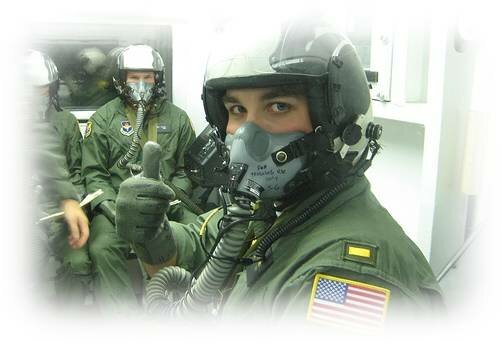
Photo courtesy of "The Jones World"
Below is U. S. Navy photo by Photographer's Mate 1st Class David A. Levy. Cleared For Release.
Pacific Ocean (July 16, 2004) -- Gunner's Mate 1st Class (DV/SW) and Sonar Technician Surface 3rd Class (DV)Jeff Griggs, Navy Divers assigned to Mobile Diving Salvage Unit One, perform pre-diving operation procedures on the Transportable Recompression Chamber System during mixed gas diving salvage operations in support of exercise Rim of the Pacific (RIMPAC) 2004. RIMPAC is the largest international maritime exercise in the waters around the Hawaiian Islands.
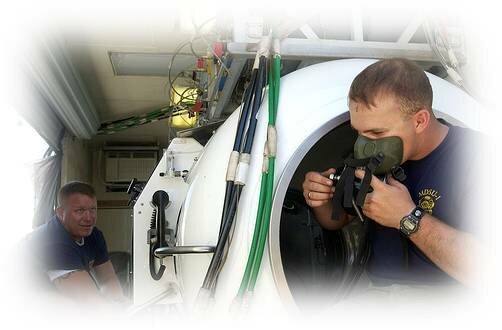
Photo courtesy of "Slagheap"
The growing requirements for safety and quality standards are driving chamber nanufacturers to invest in research and development of more sophisticated hyperbaric chambers systems. Advancements in design and quality of oxygen chambers are contributing to the growth of hyperbaric medicine.
